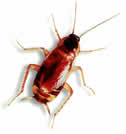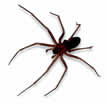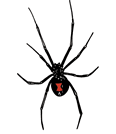Season
In this section you can find helpful information about how to identify pests that are common in the Tidewater area. These are pests that could be living in your home. Global Pest can isolate and eliminate pests, and the factors that encourage infestation.
Choose a pest
* Wood Destroying | Carpenter ants vary in size and color but are usually large (1/4-1/2 inch) and blackish. Occasionally, swarms of winged carpenter ant reproductives will emerge inside a home. Carpenter ant swarms usually occur in the spring and are a sure sign that a colony is nesting somewhere inside the structure. Winged carpenter ants can be distinguished from termites by their larger size and shape of their antennae, waist and wings. |
Argentine Ant | The Argentine ant (Linepithema humile, formerly Iridomyrmex humilis) is a tiny dark ant native to northern Argentina, Uruguay, Paraguay, and southern Brazil. The species has been inadvertently introduced by humans to many other areas of the world, such as South Africa, New Zealand, Japan, Easter Island, Australia, Hawaii, Europe, and the United States. |
Pharaoh Ant | The pharaoh ant (Monomorium pharaonis) is a small (2 mm) yellow or light brown, almost transparent ant known for being a major indoor nuisance pest, especially in hospitals. The origin of this ‘tramp’ ant is uncertain, although favoured alternatives include West Africa and Indonesia. The Pharaoh ant has been introduced to virtually every area of the world including Europe, the Americas, Australasia and Southeast Asia. Pharaoh ants are a tropical species but they thrive in buildings anywhere, even in temperate regions provided central heating is present. |
Odorous Ant | Tapinoma sessile is a species of ant that goes by the common names odorous house ant and coconut ant. This species is a scavenger/predator ant that will eat most household foods, especially those that contain sugar, and other insects. They range in color from brown to black and range in length from 1/16 to 1/8 inches ( 1.5 – 3.2 mm). |
Pavement Ant | The pavement ant, Tetramorium caespitum, is a common household pest. Their name comes from the fact that they usually make their homes in pavement. They are distinguished by two spines on the back, two nodes on the petiole, and grooves on the head and thorax. |
During early spring, colonies attempt to conquer new areas and often attack nearby enemy colonies. These result in huge sidewalk battles, sometimes leaving thousands of ants dead. Because of their aggressive nature, they often invade and colonize seemingly impenetrable areas. In summer time the ants dig out the sand in between the pavements to vent the nests.
American Cockroach | The American cockroach is a large cockroach, adults are approximately 1-1/2 inches long (38mm).The adult is a shiny reddish brown to dark brown and has a yellow margin on the pronotum (region directly behind the head). Immature American cockroaches are also reddish brown to dark brown in color and often have yellow markings on the abdomen. |
Brown Banded Cockroach | Brown-banded cockroach, Supella longipalpa, is a small species of cockroach, measuring about 5⁄8 in (10 to 14;mm) long. It is tan to light brown. It has two light-colored bands across the wings and abdomen, they may sometimes appear to be broken or irregular but are quite noticeable. Male brown-banded cockroaches have been observed to fly indoors. Among cockroach species, brown-banded cockroaches have the most distinctions between sexes. Females have larger abdomen and shorter wings than males. Brown-banded cockroaches often hide their egg cases in or under furniture. Dead spcimens have been known to be imported in furniture. |
German Cockroach | The German cockroach or Croton bug (Blattella germanica) is a small species of cockroach, measuring about 1.3 cm to 1.6 cm (1/2″ to 5/8″) long. It is tan to light brown, and has two dark parallel streaks running from the head to the base of the wings. The German cockroach is very successful at establishing a niche in buildings, and is very hardy and resilient towards attempts to exterminate them. This is due to the fact they produce a large number of nymphs for each egg case, that there is a short period between birth and sexual maturity, and their ability to easily hide due to their small size. |
Oriental Cockroach | The Oriental cockroach or waterbug (Blatta orientalis) is a large species of cockroach, measuring about 1 inch in length at maturity. It is dark brown to black in colour and has a glossy body. The female Oriental cockroach has a somewhat different appearance to the male, appearing to be wingless at casual glance but has two very short and useless wings just below its head. It has a wider body than the male. The Oriental cockroach tends to travel somewhat more slowly than other species. They are often called waterbugs since they prefer dark, moist places. They can often be found around decaying organic matter, and in sewers, drains, damp basements, porches, and other damp locations. |
Fleas | Flea is the common name for any of the small wingless insects of the order Siphonaptera (some authorities use the name Aphaniptera because it is older, but names above family rank need not follow the ICZN rules of priority, so most taxonomists use the more familiar name). Fleas are external parasites, living by hematophagy off the blood of mammals and birds. |
Ticks | Tick is the common name for the small arachnids in superfamily Ixodoidea that, along with other mites, constitute the Acarina. Ticks are ectoparasites (external parasites), living by hematophagy on the blood of mammals, birds, and occasionally reptiles and amphibians. Ticks are important vectors of a number of diseases, including Lyme disease. |
Rats | Rats are various medium sized rodents. “True rats” are members of the genus Rattus, the most important of which to humans are the black rat, Rattus rattus, and the brown rat, Rattus norvegicus. Many members of other rodent genera and families are also called rats and share many characteristics with true rats. A rat has an average life span of 2-3 years.Rats are distinguished from mice by their size; rats generally have bodies longer than 12 cm (5 in). |
Mice | A mouse (plural mice) is a small animal that belongs to one of numerous species of rodents. The best known mouse species is the common house mouse (Mus musculus). It is found in nearly all countries and, as the laboratory mouse, serves as an important model organism in biology. It is also a popular pet. The American white-footed mouse (Peromyscus leucopus) and the deer mouse (Peromyscus maniculatus) also sometimes live in houses. These species of mice live commensally with humans. |
Crickets | Crickets, family Gryllidae (also known as “true crickets”), are insects somewhat related to grasshoppers and more closely related to katydids or bush crickets (family Tettigoniidae). They have somewhat flattened bodies and long antennae. There are about 900 species of crickets. They tend to be nocturnal and are often confused with grasshoppers because they have a similar body structure including jumping hind legs. |
Termites * Wood Destroying | Subterranean termites are the most destructive insect pests of wood in the United States. They cause more than $2 billion in damage each year, more property damage than that caused by fire and windstorm combined. In nature, subterranean termites are beneficial. They break down many dead trees and other wood materials that would otherwise accumulate. The biomass of this breakdown process is recycled to the soil as humus. Problems occur when termites attack the wooden elements of human structures — homes, businesses and warehouses. Their presence is not readily noticed because they hide their activity behind wallboards, siding or wood trim. Homeowners should watch for subterranean termites and take precautions to prevent infestations. To minimize damage from termites, it is helpful to know the description, life cycle and infestation signs of termites as well as preventive and control measures. |
Silverfish | Silverfish are small, brown or silver-gray, soft insects without wings. The abdomen has three filaments extending from it. Silverfish are not often seen by homeowners because they are nocturnal and can run very swiftly. Occasionally, they are found in bathtubs. They crawl in seeking food or moisture and can’t climb out. These insects prefer vegetable matter with a high carbohydrate and protein content. However, indoors they will feed on almost anything. A partial list includes dried beef, flour, starch, paper, gum, glue, cotton, linen, rayon, silk, sugar, molds and breakfast cereals. |
Centipedes | Centipedes are terrestrial arthropods belonging to the class Chilopoda and the Subphylum Myriapoda. They are elongated metameric animals with one pair of legs per body segment. A key trait uniting this group is a pair of poison claws or forcipules formed from a modified first appendage. This also means that centipedes are an exclusively predatory taxa, which is uncommon. Worldwide there are estimated to be 8,000 species. |
Wolf Spider | Wolf spiders are members of the family Lycosidae, so named because their method of hunting is to run down their prey. They are robust and agile hunters that rely on good eyesight to hunt, typically at night. There are several genera of wolf spider, ranging in size from 1 cm to 8 cm. They have eight eyes arranged in three rows. The bottom row consists of four small eyes, the middle row has two very large eyes (which distinguishes them from the Pisauridae), and the top row has two medium-sized eyes. They depend on their eyesight, which is quite good, to hunt. |
Brown Recluse | The brown recluse spider, Loxosceles reclusa, is a well-known member of the family Sicariidae (formerly placed in a family “Loxoscelidae”). It is usually between 6–20 mm (¼ in and ¾ in) but may grow larger. It is brown and sometimes an almost deep yellow color and usually has markings on the dorsal side of its cephalothorax, with a black line coming from it that looks like a violin with the neck of the violin pointing to the rear of the spider, resulting in the nickname “fiddleback spider” or “violin spider”. Coloring varies from light tan to brown and the violin marking may not be visible. |
Black Widow | The black widow spider (Latrodectus spp.) is a spider notorious for its neurotoxic venom. It is a large widow spider found throughout the world and commonly associated with urban habitats or agricultural areas. Adult female black widow spiders are gloss black with an hourglass shaped marking on the underside of its abdomen which can range from orange to red. As with many venomous creatures, the brightly colored markings serve as a warning to predators. |























